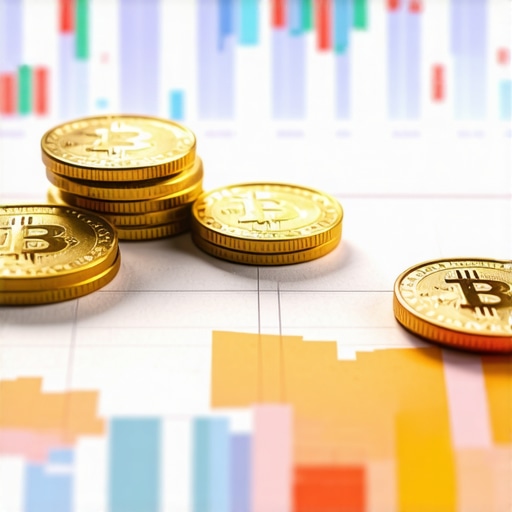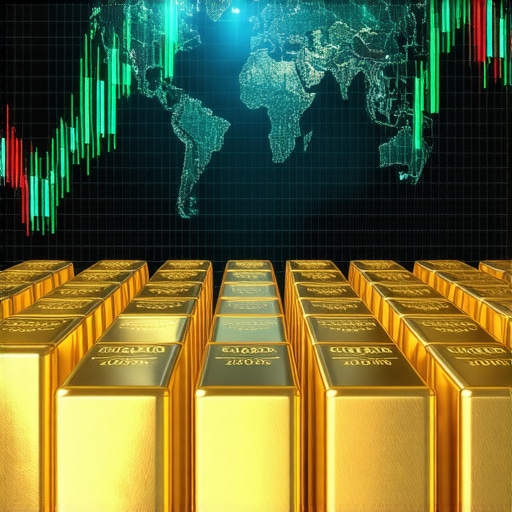Unlocking the Secrets Behind Gold Supply: A Strategic Investor’s Guide
Gold has long stood as a beacon of stability amidst economic turbulence, but truly mastering how to evaluate gold supply dynamics can elevate your investment strategy from reactive to proactive. Understanding the nuanced interplay of factors that govern gold’s availability and movement worldwide is essential for investors seeking smarter, more informed decisions that anticipate market shifts rather than merely follow them.
Decoding the Complex Web of Gold Supply Chains
The supply of gold is influenced by a multifaceted chain that includes mining production, recycling flows, and central bank activities. Mining output, while a fundamental element, is subject to geological, technological, and geopolitical constraints that can constrain or boost availability. For instance, geopolitical instability in major gold-producing regions like South Africa or Russia can disrupt supply unexpectedly, impacting global prices.
Recycling, often underestimated, plays a significant role in balancing supply and demand. During periods of high gold prices, recycling rates typically surge as holders liquidate assets, temporarily increasing supply and stabilizing prices. Conversely, when prices dip, recycling slows, tightening supply.
Central banks, as custodians of national reserves, wield substantial influence by buying or selling gold. Their policies often reflect broader economic strategies and can signal macroeconomic trends to the market. For example, recent central bank gold purchases in emerging economies have been pivotal in driving demand and price appreciation, as documented by the World Gold Council.
Supply Disruptions and Their Ripple Effects: When Mines Close and Politics Shift
Supply shocks, such as unplanned mine closures or export restrictions, can cause sudden price volatility. Mining strikes or new environmental regulations can significantly reduce output, forcing investors to reassess their positions swiftly. An illustrative case is the 2020 COVID-19 pandemic lockdowns, which disrupted mining operations globally and momentarily tightened supply, contributing to gold’s price surge.
How Can Investors Accurately Gauge Gold Supply Trends Amid Such Complexity?
Evaluating gold supply requires a blend of quantitative data analysis and qualitative judgment. Tracking mining production reports, recycling statistics, and central bank disclosures provides foundational data. However, interpreting these alongside geopolitical developments and macroeconomic indicators is critical for a holistic view.
Utilizing specialized market intelligence services and reports, such as those from the BullionVault Gold Supply & Demand Reports, can offer timely insights. Additionally, integrating supply analysis with demand-side trends, like jewelry consumption and industrial use, sharpens investment timing and portfolio allocation.
Why Understanding Gold Supply Dynamics Transforms Investment Decisions
Investors who comprehend the subtle shifts in gold supply are better positioned to anticipate price movements and identify entry or exit points. This expertise supports strategic diversification, risk management, and capitalizes on market inefficiencies.
For those eager to deepen their grasp of gold market forces, exploring resources such as Gold Supply and Demand Explained: Impact on Prices in 2025 offers comprehensive analysis tailored for today’s investor climate.
Curious about integrating gold supply insights into your investment portfolio? Share your thoughts or questions below to join a community passionate about mastering gold investment strategies.
Balancing Act: How I Navigate the Ever-Changing Gold Supply Landscape
Reflecting on my years of investing in gold, I’ve realized that staying attuned to supply dynamics is less about obsessively tracking every headline and more about cultivating a keen sense of market rhythms. For instance, when mining reports indicate production dips due to geopolitical tensions or environmental regulations—as seen recently in parts of South America—I immediately consider how this might tighten supply and create upward price pressure. It’s a delicate dance between reacting quickly and avoiding knee-jerk decisions.
One personal strategy I’ve found invaluable is layering supply-side analysis with demand insights. Jewelry demand, for example, might surge during festival seasons in key markets like India or China, amplifying the impact of a constrained supply. Combining this with insights from trusted sources, such as the analysis of global gold demand trends, helps me build a more holistic picture before making buying or selling decisions.
Recycling’s Role: More Than Just Scraps
At first, I underestimated how significant recycling can be as a gold supply buffer. During volatile market phases, I noticed spikes in recycled gold availability that temporarily eased price surges. When prices peak, people tend to cash in on old jewelry and coins, flooding the market with recycled gold. Conversely, when prices dip, recycling activity usually slows down. Recognizing this pattern has helped me anticipate shifts in supply pressure that are not immediately obvious from mining data alone.
Central Banks: The Quiet Giants Influencing Gold Supply
Central bank activity is another fascinating piece of the puzzle. I recall a period when emerging market central banks increased their gold reserves steadily, signaling a move away from traditional fiat currency exposure. This subtle shift had broader implications for gold’s supply-demand balance and price trajectory. Keeping tabs on these moves requires regular review of central bank reports and statements, which often provide early clues about market sentiment and strategic positioning.
Have You Ever Wondered How Political Instability in Gold-Producing Countries Affects Your Investment?
This is a question I often ask myself and fellow investors. Political upheavals or regulatory changes in countries like Russia, South Africa, or Peru can abruptly disrupt mining output, causing supply shortages. These disruptions tend to ripple through the global market, sometimes leading to rapid price spikes. Staying informed through news outlets and specialized market reports helps me anticipate these risks and adjust my portfolio accordingly.
For anyone looking to deepen their understanding, the World Gold Council is an excellent resource that offers detailed insights into how central bank policies shape gold demand and supply dynamics worldwide.
Practical Tips from My Experience for Smarter Gold Supply Analysis
- Track multiple data sources: Relying solely on mining output or price charts can be misleading. Incorporate recycling data, central bank activity, and geopolitical news for a complete picture.
- Integrate demand-side trends: Understand how cultural events, industrial demand, and investment flows influence gold consumption.
- Leverage expert reports: Resources like Gold Supply and Demand Explained offer tailored analysis that can save you time and sharpen your strategy.
- Stay patient and avoid overreacting: Market noise can tempt quick moves, but gold supply trends often unfold gradually. A measured approach usually yields better outcomes.
What’s your experience with tracking gold supply and its impact on your investments? I’d love to hear your stories or questions—feel free to share in the comments below. If you’re curious about further strategies, check out this comprehensive guide for an even deeper dive.
Central Banks’ Strategic Gold Movements: Decoding Hidden Signals in Reserve Management
Central banks don’t merely accumulate gold as a passive safeguard; their gold reserve strategies often communicate nuanced economic and geopolitical intentions. For example, a central bank’s gradual increase in gold holdings can signal a deliberate pivot away from reliance on the US dollar or other fiat currencies, reflecting concerns about currency devaluation or geopolitical instability. Conversely, selling gold reserves may indicate liquidity needs or confidence in other assets. The timing and scale of these transactions are meticulously analyzed by sophisticated investors to anticipate shifts in macroeconomic trends.
Understanding these subtle signals requires a deep dive into central bank balance sheets, often disclosed in quarterly or annual reports, and cross-referencing this data with geopolitical developments and monetary policy announcements. For instance, the International Monetary Fund’s International Financial Statistics provides comprehensive datasets that savvy investors utilize to track these movements in real time.
Recycling Dynamics: Beyond the Surface of Secondary Gold Supply
While mining output forms the backbone of gold supply, recycled gold serves as a critical balancing mechanism, especially during market fluctuations. Unlike primary production, recycling supply is highly elastic and responsive to price signals. When gold prices soar, the incentive to recycle old jewelry, dental gold, and industrial scraps intensifies, abruptly increasing supply and often tempering price spikes.
However, the intricacies of recycling go beyond simple volume metrics. The purity, geographic origin, and form of recycled gold can influence market liquidity and accessibility. For example, recycled gold from regions with less stringent refining standards may introduce quality variability, affecting wholesale pricing and investor confidence. Advanced investors track these micro-level supply chain details to anticipate subtle shifts in availability and price stability.
How Can Fluctuations in Geopolitical Stability in Gold-Producing Countries Be Quantitatively Integrated into Supply Forecast Models?
Integrating geopolitical risk factors into gold supply forecasting models is an advanced, yet indispensable, practice for sophisticated investors. Quantitative methods such as scenario analysis combined with probabilistic risk assessment enable the incorporation of variables like political unrest, regulatory changes, and export restrictions. Data sources include country risk indices from institutions like the Economist Intelligence Unit and real-time news analytics that feed into machine learning models predicting mining disruptions.
For example, a sudden escalation in civil unrest in South Africa, a major gold producer, can be modeled to estimate potential output reductions and the resultant supply shock impact on global prices. By integrating these forecasts with traditional supply-demand metrics, investors can optimize portfolio hedging strategies and timing decisions with greater precision.
Leveraging Cutting-Edge Analytics for Real-Time Supply Chain Intelligence
Emerging technologies such as blockchain and satellite imagery have begun to revolutionize gold supply chain transparency. Blockchain enables traceability from mine to market, reducing the opacity that traditionally obscured supply disruptions or illicit trade. Meanwhile, satellite monitoring offers near real-time insights into mining activity levels, infrastructure development, and logistical bottlenecks.
Investors equipped with access to these data streams can detect early warning signs of supply constraints or surges before they manifest in public reports or pricing. This edge is particularly valuable in volatile environments where timing and information asymmetry dictate investment outcomes.
Embracing these advanced tools requires not only technical capability but also a strategic mindset that integrates multidisciplinary data sources into coherent investment theses.
For those committed to mastering the complexities of gold supply, exploring these innovative analytics is an essential next step. Dive deeper into the intersection of technology and precious metals markets by visiting World Gold Council Research.
If you’re intrigued by how these sophisticated approaches can elevate your investment strategy, subscribe to our newsletter for regular expert insights and detailed analyses tailored to the evolving gold market landscape.
Integrating Geopolitical Risk into Sophisticated Gold Supply Forecasting
While traditional gold supply metrics offer foundational insights, expert investors increasingly recognize the imperative to embed geopolitical risk factors directly into their forecasting models. This integration transcends simple awareness, employing advanced quantitative techniques such as scenario planning, probabilistic risk assessments, and machine learning algorithms to capture the multifaceted impact of political instability, regulatory shifts, or trade embargoes on mining output and export flows.
For instance, leveraging country risk indices and dynamic news analytics from trusted organizations like the Economist Intelligence Unit enables the construction of probabilistic models that quantify potential supply disruptions. This approach not only refines price volatility predictions but also empowers investors to calibrate hedging strategies and position sizing with enhanced precision, mitigating downside risks in volatile geopolitical climates.
How Can Advanced Data Science Techniques Enhance Predictive Accuracy in Gold Supply Disruption Models?
Advanced data science methodologies, including natural language processing and real-time sentiment analysis of geopolitical news, can be integrated with satellite imagery and blockchain data streams to generate highly granular, predictive insights into gold supply chain stability. These techniques allow investors to detect subtle shifts in mining activity or regulatory sentiment before traditional reports disseminate, providing a crucial temporal advantage. By fusing heterogeneous data sources within machine learning frameworks, predictive models achieve superior robustness and adaptability to rapidly evolving market conditions.
Emerging Technologies Revolutionizing Gold Supply Chain Transparency
Technological innovations such as blockchain and satellite surveillance are redefining the landscape of gold supply analytics. Blockchain’s immutable ledger capabilities facilitate end-to-end traceability, curbing illicit trade and elevating confidence in supply authenticity. Concurrently, high-resolution satellite imagery enables near real-time monitoring of mining operations, infrastructure developments, and transport routes, offering unprecedented visibility into physical supply constraints or expansions.
Adopting these tools equips investors with actionable intelligence to anticipate supply bottlenecks, logistical delays, or surges well ahead of price adjustments. This technological edge is rapidly becoming indispensable for market participants aiming to maintain competitive advantage in an increasingly complex gold market environment.

Harnessing Multidisciplinary Insights: A Strategic Imperative for Gold Investors
Mastering gold supply dynamics today mandates a multidisciplinary approach that synthesizes geopolitical intelligence, advanced analytics, and technological innovations. Investors who adeptly navigate these intersecting domains are positioned to decode subtle market signals, optimize timing for portfolio reallocations, and enhance risk-adjusted returns.
To elevate your analytical arsenal, consider exploring the World Gold Council’s Research Portal, which offers cutting-edge studies on supply chain transparency and macroeconomic influences. Engaging with such authoritative resources not only fortifies your strategic framework but also connects you with a community of experts dedicated to evolving gold investment methodologies.
Ready to transform your gold investment approach with these advanced insights? Subscribe to our newsletter for in-depth analyses and expert commentary that empower you to anticipate market shifts with confidence and precision.
Frequently Asked Questions (FAQ)
What are the main components that influence global gold supply?
The global gold supply is primarily shaped by mining production, recycled gold, and central bank transactions. Mining output depends on geological availability and geopolitical stability, recycled gold responds elastically to price fluctuations, and central banks’ reserve activities reflect macroeconomic strategies that can alter supply-demand balances significantly.
How does geopolitical instability in gold-producing countries impact gold prices?
Political unrest, regulatory changes, or export restrictions in major gold-producing regions can abruptly reduce mining output, creating supply shortages. These disruptions often lead to sharp price volatility as markets react to constrained availability, emphasizing the need for investors to monitor geopolitical risk indicators closely.
Why is recycling such a critical factor in gold supply analysis?
Recycling acts as a flexible buffer in the gold supply chain. When prices rise, increased recycling floods the market with secondary gold, easing supply pressures. Conversely, lower prices discourage recycling, tightening supply. Recognizing these patterns allows investors to anticipate supply shifts beyond traditional mining data.
How can central bank gold transactions signal broader economic trends?
Central banks’ gold reserve changes often indicate shifts in monetary policy or geopolitical positioning. For example, accumulation may signal diversification away from fiat currencies due to economic uncertainty, while selling might reflect liquidity needs or confidence in other assets. Tracking these moves provides insights into underlying market sentiment.
What advanced techniques exist to integrate geopolitical risk into gold supply forecasting?
Investors employ scenario analysis, probabilistic risk assessment, and machine learning models that incorporate country risk indices and real-time news sentiment. These quantitative methods enable more precise predictions of supply disruptions caused by political instability, enhancing portfolio risk management.
How are emerging technologies transforming gold supply chain transparency?
Technologies like blockchain offer immutable traceability from mine to market, reducing opacity and illicit trade. Satellite imagery provides near real-time monitoring of mining activity and logistics, enabling early detection of supply bottlenecks. Together, these innovations grant investors unprecedented visibility and timing advantages.
Can demand-side factors influence gold supply dynamics?
Absolutely. Demand from jewelry, industry, and investment flows interacts with supply constraints to drive price movements. For instance, seasonal spikes in jewelry demand can amplify the impact of limited supply, underscoring the importance of integrating both supply and demand analyses for comprehensive market insight.
How do expert investors avoid overreacting to market noise in gold supply data?
Experienced investors maintain a patient, measured approach, recognizing that gold supply trends often evolve gradually. By cross-referencing multiple data sources and contextualizing news within broader market cycles, they avoid impulsive decisions driven by short-term volatility.
What role do specialized market intelligence reports play in gold investment?
Reports from reputable sources gather and analyze diverse data sets—such as mining output, recycling rates, and central bank activity—offering timely, actionable insights. Leveraging these expert analyses allows investors to refine timing, manage risks, and capitalize on emerging supply-demand imbalances.
How can individual investors start integrating sophisticated gold supply insights into their portfolios?
Begin by tracking key indicators like mining reports, recycling trends, and central bank disclosures, complemented by geopolitical news. Utilize expert resources and gradually incorporate advanced analytics or technology-driven data as familiarity grows. Consistent learning and patience are vital to mastering this complex but rewarding area.
Trusted External Sources
- World Gold Council (https://www.gold.org): Authoritative for comprehensive data on gold demand, supply, and central bank activities, offering in-depth research and market intelligence essential for expert investors.
- International Monetary Fund (https://data.imf.org): Provides detailed financial statistics and data on central bank gold reserves globally, critical for analyzing macroeconomic impacts on gold supply.
- Economist Intelligence Unit (https://www.eiu.com): Offers country risk indices and geopolitical analysis used to quantitatively integrate political risk into supply forecasting models.
- BullionVault Gold Supply & Demand Reports (https://www.bullionvault.com/gold-supply-demand): Delivers timely market intelligence combining supply and demand metrics, assisting investors in identifying price drivers.
- World Gold Council Research Portal (https://www.gold.org/research): Features cutting-edge studies on gold supply chain transparency, technological innovations, and macroeconomic influences, supporting advanced strategic decision-making.
Conclusion
Understanding gold supply dynamics is pivotal for investors aiming to navigate the precious metals market with strategic foresight. By dissecting the interplay among mining production, recycling flows, and central bank maneuvers—while integrating geopolitical risk and leveraging emerging technologies—investors can anticipate market shifts with enhanced accuracy. This multidisciplinary approach transforms reactive investing into proactive portfolio management, optimizing risk-adjusted returns amid evolving global conditions. Embracing expert resources, advanced analytics, and patient market observation equips you to seize opportunities and mitigate risks inherent in gold investments. Ready to elevate your gold investment strategy? Share your insights, engage with our expert community, and explore further resources to deepen your mastery of gold supply complexities.










